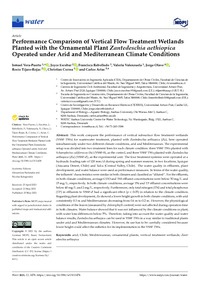Mostrar el registro sencillo de la publicación
Performance comparison of vertical flow treatment wetlands planted with the ornamental plant zantedeschia aethiopica operated under arid and mediterranean climate conditions
| dc.contributor.author | Vera-Puerto, Ismael L. | |
| dc.contributor.author | Escobar, Joyce | |
| dc.contributor.author | Rebolledo, Francisca | |
| dc.contributor.author | Valenzuela, Valeria | |
| dc.contributor.author | Olave, Jorge | |
| dc.contributor.author | Tíjaro-Rojas, Rocío | |
| dc.contributor.author | Correa-Becerra, Christian | |
| dc.contributor.author | Arias, Carlos | |
| dc.date.accessioned | 2022-01-19T12:30:14Z | |
| dc.date.available | 2022-01-19T12:30:14Z | |
| dc.date.issued | 2021 | |
| dc.identifier.uri | http://repositorio.ucm.cl/handle/ucm/3739 | |
| dc.description.abstract | This work compares the performance of vertical subsurface flow treatment wetlands (VSSF TWs) for wastewater treatment, planted with Zantedeschia aethiopica (Za), here operated simultaneously under two different climate conditions, arid and Mediterranean. The experimental setup was divided into two treatment lines for each climate condition: three VSSF TWs planted with Schoenplectus californicus (Sc) (VSSF-S), as the control, and three VSSF TWs planted with Zantedeschia aethiopica (Za) (VSSF-Z), as the experimental unit. The four treatment systems were operated at a hydraulic loading rate of 120 mm/d during spring and summer seasons, in two locations, Iquique (Atacama Desert, Chile) and Talca (Central Valley, Chile). The water quality in effluents, plant development, and water balance were used as performance measures. In terms of the water quality, the influents’ characteristics were similar in both climates and classified as “diluted”. For the effluents, in both climate conditions, average COD and TSS effluent concentrations were below 50 mg/L and 15 mg/L, respectively. In both climate conditions, average TN and TP effluent concentrations were below 40 mg/L and 2 mg/L, respectively. Furthermore, only total nitrogen (TN) and total phosphorus (TP) in effluents to VSSF-Z had a significant effect (p < 0.05) in relation to the climate condition. Regarding plant development, Za showed a lower height growth in both climate conditions, with arid consistently 0.3 m and Mediterranean decreasing from 0.6 m to 0.2 m. However, the physiological conditions of the leaves (measured by chlorophyll content) were not affected during operation time in both climates. Water balance showed that it was not influenced by the climate conditions or plant, with water loss differences below 5%. Therefore, taking into account the water quality and water balance results, Zantedeschia aethiopica can be used in VSSF TWs in a way similar to traditional plants under arid and Mediterranean climates. However, its use has to be carefully considered because lower height could affect the esthetics for its implementation in the VSSF TWs. | es_CL |
| dc.language.iso | en | es_CL |
| dc.rights | Atribución-NoComercial-SinDerivadas 3.0 Chile | * |
| dc.rights.uri | http://creativecommons.org/licenses/by-nc-nd/3.0/cl/ | * |
| dc.source | Water, 13(11), 1478 | es_CL |
| dc.subject | Arid | es_CL |
| dc.subject | Chile | es_CL |
| dc.subject | Mediterranean | es_CL |
| dc.subject | Ornamental plants | es_CL |
| dc.subject | Vertical treatment wetlands | es_CL |
| dc.subject | Zantedeschia aethiopica | es_CL |
| dc.title | Performance comparison of vertical flow treatment wetlands planted with the ornamental plant zantedeschia aethiopica operated under arid and mediterranean climate conditions | es_CL |
| dc.type | Article | es_CL |
| dc.ucm.facultad | Facultad de Ciencias de la Ingeniería | es_CL |
| dc.ucm.indexacion | Scopus | es_CL |
| dc.ucm.indexacion | Isi | es_CL |
| dc.ucm.uri | www.mdpi.com/2073-4441/13/11/1478 | es_CL |
| dc.ucm.doi | doi.org/10.3390/w13111478 | es_CL |



